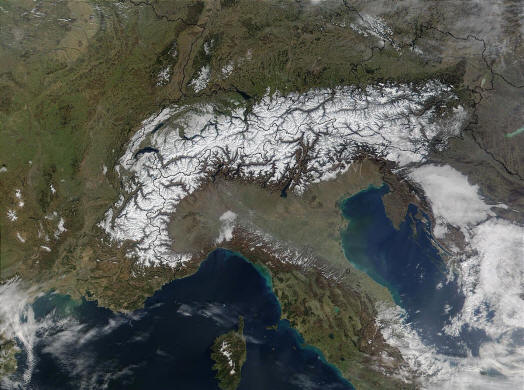|

The Alps from space. Could they be a
relatively new mountain range and
not millions of years old? Credit:
Jacques Descloitres, MODIS Land
Rapid Response Team, NASA/GSFC
Earth Cycles
Mar
15, 2010
It is a commonly held belief that
events on Earth progress according
to cycles.
One of the principle tenets of
Electric Universe theory is that
Earth and the Solar System have
experienced catastrophic reordering
and resurfacing perhaps as little as
5000 years ago. The time varies, but
most adherents to the theory
consider 10,000 years ago to be as
far back as we need to look for the
events to have occurred.
Prevailing geological theories state
that it took millions, if not
billions, of years to arrange the
scenery on our planet. Mountains
rise in response to mechanisms that
are so slow as to be undetectable
over all the millennia of human
history: the Himalayas, the Alps,
and the Rocky Mountains, for
example, retain the shapes that were
visible to ancient nomadic tribes
that wandered the continents in ages
past.
The seas, it is said, have not left
their basins in time spans that have
no meaning to the human mind. The
Atlantic Ocean has bridged the
distance between Africa, Europe, and
the Americas for a period greater
than the human species has existed
on Earth.
Rivers, deserts, canyons—all appear
to our modern eyes just as they
would have appeared to Alexander the
Great, Goyathlay, Sargon, or Khufu.
The cyclic processes of erosion or
sediment deposition are the same
today as they were long ago. Most of
the current methods for dating
artifacts, geologic layers, or
fossils are dependent on that
hypothesis of gradual, uniform
action.
What if the uniformitarian
hypothesis is incorrect? What would
be the ramifications if carbon
dating, potassium-argon, or the
so-called "geologic column" were not
reliable windows to the past? What
if the topography of Earth was
created in a period of time so short
that ancient civilizations were able
to record it? What meaning would the
Neolithic, or the Jurassic, or the
Precambrian eras have?
Coal beds cover millions of square
kilometers all over the world.
Insects, leaves, trees, rocks, and
animal bones are found inside them,
although hardly any intact forms
exist. The majority are
disarticulated, shredded, or
crushed. Carbonized trees are
sometimes found standing upright in
a few coal seams, extending down
through many layers that are said to
progress through eons of time, 250
to 500 million years. Mineralized
trees, called "petrified wood,"
cover large areas of the American
prairie. The prairie, itself, rests
on top of gravel deposits in some
cases hundreds of meters deep. There
are trilobites, pterosaurs, palm
trees, fir trees, dragonflies—all
preserved for what is said to be
millions, hundreds of millions, and
even billions of years in a variety
of minerals. Some are entangled in
mountain-high piles, with multitudes
of different species from every era
mixed together in a splintered mass.
When did these plants and animals,
all strong, all "fit," all perfectly
adapted to their environments, meet
their dooms? What caused the forests
to burn, or freeze, and then succumb
to petrification?
Once again, the primary assumption
in the development of dating systems
is that the Earth is an isolated
planet that does not interact with
other celestial bodies. Planetary
scientists do say that there have
been meteor impacts of staggering
size, but nothing like that has
taken place for the aforementioned
millions of years. The large
craters, such as Popigai or
Chicxulub, date back to the Jurassic
Age.
An additional aspect to the
uniformitarian hypothesis is that
radioactive decay rates have never
changed since the radioactive
elements were formed, and no
alteration to Earth's electric or
magnetic fields have taken place.
Geologists rely on a smooth,
continuous clock ticking off the
millennia at a measurable rate. If
that is not the case, then the Age
of the Dinosaurs, or the formation
of the ocean basins, could have
occurred at any point in the past,
or over any length of time.
It seems possible that plasma
interactions with Earth and other
charged bodies in space or the
impact on our biosphere from ion
beams could disrupt all the
elemental changes that are used to
date rocks. Earth could be much
younger than the billions of years
commonly ascribed to it, or much
older. If Electric Universe concepts
are found to be more reasonable than
previous theories, that cataclysmic
events completely overturned the
familiar environment that older
peoples experienced, then we have no
"clocks" and no "calendars" to use,
except those that came into being a
mere 100 generations ago.
Stephen Smith
|







